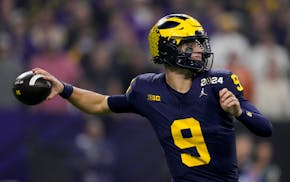At 3:30 p.m. Tuesday, you receive a lineup sheet that displays this information about the Twins' opponent: Chris Sale has a 2.75 ERA and the Red Sox are 49-24.
At 3:45, you enter the Twins clubhouse and see the lineup features Robbie Grossman, Ehire Adrianza, Taylor Motter, Mitch Garver and Ryan LaMarre batting consecutively in what was not, according to media reports, designed to be a spring training split-squad contest. The five have produced eight big-league home runs this season.
At 3:55, Twins second baseman Brian Dozier says: "It's that time of the year. Things start happening in July."
At 4 p.m. Jason Castro enters on crutches, wearing a brace on his right knee.
There was optimism in the clubhouse Tuesday because the Twins won two of three at Cleveland this weekend. There was optimism after the game because the Twins, with that lull-'em-to-sleep lineup, beat Sale and the Sox 6-2 behind Eduardo Escobar's latest star turn.
But everywhere you looked other than the late-night scoreboard there was evidence that this team needs help, and that it can't afford to wait for Miguel Sano and Byron Buxton to find their way back to the majors.
The Twins have built one of the deepest rotations in franchise history, and proved during the second half of last season that their current roster, if relatively healthy, can produce runs.
The front office proved last summer that it can be aggressive at the trade deadline, whether acquiring or dispatching players, and proved this winter that it will make aggressive moves to help this particular team win.
There is one move that Derek Falvey and Thad Levine should consider making that would serve the dual purposes of helping this team survive and set up this franchise to win in the coming years. They should look for a starting-caliber catcher who can handle the pitching staff and deepen the lineup, and stick around for a while.
Garver remains an intriguing hitting prospect who needs work behind the plate. Bobby Wilson brings savvy and defense but won't hit much. If Buxton and Sano were performing as projected, the Twins could afford to field a purely defensive catcher, but that isn't happening now and might not happen anytime soon.
Castro is a career .231 hitter who has hit better than .222 once since 2014. He is out for the season because of a torn meniscus. If he returns to full health for 2019, the last year of his contract with the Twins, he should again be a defensive asset, but he should not be expected to hit.
The Twins have built a strong enough farm system that they should be able to find a catcher on the market sometime between now and the trading deadline, and they might never need the help more than they do now.
They are relying on two Everyday Eddies, a second baseman who hasn't gotten hot yet and a first baseman who recently recovered from concussion symptoms.
If the goal is to contend this season, a two-way catcher is vital. If the goal is to win a championship in the near future, a two-way catcher is vital.
The type of quick-fix, roll-the-dice, trade-deadline deals that fans so often scream for don't work out all that well all that often. That's why the Twins shouldn't look for a monthly rental — they should find a solution for what could become a persistent problem.
With so many teams out of contention already, the Twins should be able to find trade partners, and they did a deal this winter with the Rays for Jake Odorizzi.
The Rays catcher is former Twin Wilson Ramos, a talented player and power hitter who could bat in the middle of the Twins lineup. He is in the second year of a two-year deal and could find that his former home is his future home. If he were acquired this summer and performed well, the Twins could easily afford to sign him to a long-term deal.
Ramos, or someone like him, would make the Twins less dependent on players who aren't even here.
Jim Souhan's podcast can be heard at MNSPN.com. On Twitter: @SouhanStrib. • jsouhan@startribune.com

Souhan: Wolves fans made Game 1 special. Now bring on Game 2.

Souhan: Should Vikings even consider McCarthy in NFL draft?

Souhan: NAW erases Suns' lead, Game 1 advantage with big performance

Souhan: This is KAT's chance to prove Flip Saunders was right


